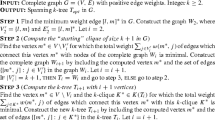Abstract
The generalized access network design problem consists of finding a topology, capacity assignment and routing that minimize the sum of costs to connect every pair of remote unit and its central node specified by the telecommunication company. We consider an integer programming formulation with a partial multicommodity structure. We analyze some aspects and extensions of the proposed model and we introduce a heuristic based on Lagrangian relaxation and the subgradient method. We report computational results for a set of randomly generated test problems. They include networks with up to 300 nodes and show that even problem instances defined in small networks can be extremely difficult problems. The heuristic generates effective and acceptable designs from the practical point of view. We compare our heuristic with a commercial code.
Similar content being viewed by others
References
A. Agrawal, P.N. Klein and R. Ravi, When trees collide: An approximation algorithm for the generalized Steiner problem on networks, Technical Report CS-90-32, Department of Computer Science, Brown University, Providence, RI (1994).
A. Balakrishnan and K. Altinkemer, Using a hop-constrained model to generate alternative communication network design, ORSA Journal on Computing 4 (1992) 192–205.
A. Balakrishnan, T.L. Magnanti and P. Mirchandani, Modeling and heuristic worst-case performance analysis of two-level network design problem, Management Science 40 (1994) 846–867.
A. Balakrishnan, T.L. Magnanti, A. Shulman and R.T. Wong, Model for planning capacity expansion in local access telecommunication networks, Annals of Operations Research 33 (1991) 239–284.
A. Balakrishnan, T.L. Magnanti and R.T. Wong, A dual-ascent procedure for large-scale uncapacitated network design, Operations Research 37 (1989) 716–740.
F. Barahona, Network design using cut inequalities, SIAM Journal on Optimization 6(3) (1996) 823–837.
J.E. Beasley, An algorithm for solving large capacitated warehouse location problems, Journal of the Operational Research Society 33 (1988) 314–325.
D. Bertsekas and R. Gallager, Data Networks (Prentice-Hall, Englewood Cliffs, NJ, 1987).
D. Bienstock and O. Günlük, Computational experience with a difficult mixed integer multicommodity flow problem, Mathematical Programming 68 (1995) 213–237.
D. Bienstock and O. Günlük, Capacitated network design – polyhedral structure and computation, Journal on Computing 8(3) (1996) 243–259.
R.R. Boorstyn and H. Frank, Large-scale network topological optimization, IEEE Transactions on Communications 25 (1977) 29–47.
M.L. Fisher, The Lagrangean relaxation method for solving integer programming problems, Management Science 27 (1981) 1–18.
M.L. Fisher, An application oriented guide to Lagrangean relaxation, Interfaces 15 (1985) 10–21.
B. Gavish, Topological design of centralized computer networks – formulations and algorithms, Networks 12 (1982) 355–377.
B. Gavish, Formulations and algorithms for the capacitated minimal directed tree, Journal of the ACM 30 (1983) 118–132.
B. Gavish, Topological design of telecommunication networks – Local access design methods, Annals of Operations Research 33 (1991) 17–71.
A.M. Geoffrion, Lagrangean relaxation for integer programming, Mathematical Programming Study 2 (1974) 82–114.
L. Hall, Experience with a cutting plane algorithm for the capacitated spanning tree problem, Journal on Computing 8(3) (1996) 219–234.
D.S. Hochbaum and A. Segev, Analysis of a flow problem with fixed charges, Networks 19 (1989) 291–312.
K. Holmberg and J. Hellstrand, Solving the uncapacitated network design problem by a Lagrangean heuristic and branch-and-bound, Operations Research 46(2) (1998) 247–259.
M.J. Lee and J.R. Yee, An algorithm for optimal minimax routing in ATM networks, Annals of Operations Research 49 (1994) 185–206.
Y. Lee, S.Y. Chiu and J. Ryan, A branch and cut algorithm for a steiner tree-star problem, Journal on Computing 8(3) (1996) 194–201.
H.P.L. Luna, N. Ziviani and R.M.B. Cabral, The telephonic switching centre network problem: Formalization and computational experience, Discrete Applied Mathematics 18 (1987) 199–210.
T.L. Magnanti and P. Mirchandani, Shortest paths, single origin–destination network design and associated polyhedra, Networks 23 (1993) 103–121.
T.L. Magnanti and R.T. Wong, Network design and transportation planning: Models and algorithms, Transportation Science 18 (1984) 1–55.
G.R. Mateus and C.T. Bornstein, Dominance criteria for the capacitated warehouse location problem, Journal of the Operational Research Society 42 (1991) 145–149.
G.R. Mateus, F.R.B. Cruz and H.P.L. Luna, Algorithm for hierarchical network design, Location Science 2 (1994) 149–164.
G.R. Mateus and H.P.L. Luna, Decentralized decision-making and capacitated facility location, The Annals of Regional Science 26 (1992) 361–377.
G.R. Mateus, H.P.L. Luna and L.C.M. Lage, Optimal planning of telecommunication networks with logical and physical aspects, in: SBT/IEEE Telecommunications Congress, Rio de Janeiro, Brasil, 1990, pp. 602–607.
G.R. Mateus and J.M. Thizy, Exact sequential choice of locations in a network, Annals of Operations Research 86 (1999) 199–219.
A. Mirzaian, Lagrangian relaxation for the star-star concentrator location problem: Approximation algorithm and bounds, Networks 15 (1985) 1–20.
A.S. Tanenbaum, Computer Networks (Prentice-Hall, New York, 1981).
R.E. Tarjan, Data Structures and Network Algorithms (SIAM, Philadelphia, PA, 1983).
Using the CPLEX Callable Library and CPLEX Mixed Integer Library, CPLEX Optimization (Incline Village, NV, 1993).
Rights and permissions
About this article
Cite this article
Mateus, G.R., Franqueira, R.V.L. Model and heuristic for a generalized access network design problem. Telecommunication Systems 15, 257–271 (2000). https://doi.org/10.1023/A:1019147029476
Issue Date:
DOI: https://doi.org/10.1023/A:1019147029476




